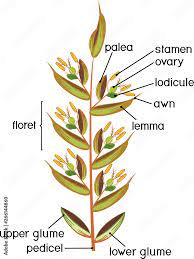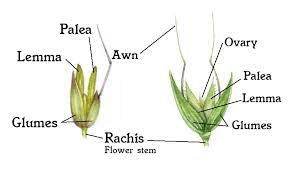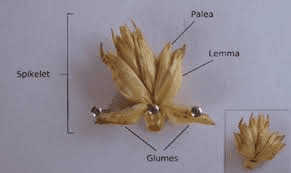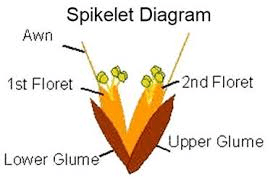Millet glumes are essential components of the millet flower structure, serving crucial protective roles in the development and preservation of the seeds. Millet, a group of small-seeded grasses including varieties such as pearl millet, foxtail millet, proso millet, and finger millet, features glumes as part of its reproductive anatomy.
Glumes are the outermost bracts that enclose the flower and the developing seed in grasses, including millet. There are usually two types of glumes: the lower glume, which is the first bract below the flower, and the upper glume, which is positioned just above the flower. Both glumes play a protective role, but their specific structure and function can vary depending on the millet variety.
The primary function of the glumes is to protect the flower and seed during their development. They form a tough, outer layer that shields the delicate reproductive parts from physical damage, pests, and environmental stresses such as wind and rain. The toughness of the glumes helps prevent damage to the developing seed and can contribute to its longevity and viability.
In addition to protection, the glumes also play a role in seed development. As the flower matures, the glumes enclose the seed, helping to secure it within the flowering structure. This enclosure helps maintain the seed’s position and provides a stable environment for its growth.
The appearance of the glumes can vary widely among different millet species. For instance, in pearl millet, the glumes are often relatively large and thick, providing robust protection to the seed. In contrast, foxtail millet has glumes that are smaller and more flexible, reflecting its adaptation to different growing conditions.
The glumes can also be an important feature for distinguishing between different millet varieties. Their size, shape, and texture may vary, providing clues to researchers and farmers for identifying and classifying millet types. This is particularly useful in breeding programs and in ensuring accurate variety identification for cultivation and consumption.
During the processing of millet, the glumes are typically removed along with the lemma and other protective layers in a process called dehulling. This step separates the edible part of the seed from the inedible outer layers. Removing the glumes is essential for making millet seeds suitable for consumption and for processing into various food products.
Understanding the role and characteristics of glumes is important in millet cultivation and seed quality management. Research into the genetic and physiological aspects of glumes can lead to the development of millet varieties with improved seed protection and better adaptation to environmental stresses. This research contributes to higher yields and better-quality crops.
Millet glumes are vital protective structures in the millet flower, serving to shield the flower and seed from damage and environmental stress. Their role in enclosing and securing the developing seed makes them crucial for successful seed development and preservation. The characteristics of glumes vary among millet species, providing valuable information for variety identification and breeding.
Their removal during processing is necessary for making millet seeds suitable for consumption, and understanding their function and structure can enhance millet cultivation practices and seed quality.
The Economic Importance and Uses of Millet Glumes

1. Grain Protection: Millet glumes are the protective outer coverings of the millet seed. They help shield the grain from pests, diseases, and environmental conditions.
2. Seed Germination: The glumes protect the developing seed until it is ready to germinate, ensuring successful seedling emergence.
3. Livestock Feed: Glumes, after separating from the grain, can be used as roughage in livestock feed, providing additional fiber and nutrients.
4. Mulching Material: Millet glumes can be used as mulch to help retain soil moisture, suppress weeds, and regulate soil temperature.
5. Compost Ingredient: The glumes can be added to compost piles, where they decompose and contribute to nutrient-rich compost for gardens and farms.
6. Biofuel Production: Millet glumes can be processed into biofuel, such as ethanol, contributing to renewable energy sources.
7. Erosion Control: Used in erosion control practices, millet glumes help stabilize soil and prevent erosion by forming a protective layer on the soil surface.
8. Craft Materials: Millet glumes can be used in crafting and making natural decorations or functional items, such as woven products.
9. Soil Amendment: When decomposed, millet glumes add organic matter and improve soil health, enhancing soil fertility and structure.
10. Animal Bedding: Dried millet glumes can be used as bedding material for livestock, providing a comfortable and absorbent surface.
11. Carbon Sequestration: Millet glumes contribute to carbon sequestration when used as biomass or incorporated into the soil, helping mitigate climate change.
12. Biomass Energy: Millet glumes can be used as biomass for energy production, providing a renewable source of heat and electricity.
13. Traditional Medicine: In some cultures, millet glumes are used in traditional medicine for their potential health benefits.
14. Green Manure: Millet glumes can be used as green manure, adding organic matter and nutrients to the soil when decomposed.
15. Packaging Material: Millet glumes can be used as biodegradable packaging material, providing an eco-friendly alternative to plastic.
16. Livestock Feed Supplement: Millet glumes can be included in animal feed mixes, supplementing livestock diets with additional fiber and nutrients.
17. Soil Fertility Improvement: The decomposition of millet glumes adds valuable nutrients to the soil, enhancing its fertility and promoting healthy plant growth.
18. Educational Uses: Millet glumes can be used in educational settings to teach about plant anatomy, seed protection, and agricultural practices.
Read Also: 23 Medicinal Health Benefits Of Aster Tataricus (Tatarian aster)
The Products and By-products That Can Be Derived From Millet Glumes

1. Livestock Feed: Millet glumes are used as roughage in livestock feed, providing fiber and nutrients.
2. Mulch: Glumes can be spread over soil as mulch to retain moisture, suppress weeds, and regulate soil temperature.
3. Compost: Millet glumes are added to compost piles, where they decompose and contribute to nutrient-rich compost for gardens and farms.
4. Biofuel: Glumes can be processed into biofuel, such as ethanol, contributing to renewable energy sources.
5. Craft Materials: Millet glumes can be used in crafting, including making natural decorations and woven products.
6. Soil Amendment: Decomposed glumes improve soil health by adding organic matter and enhancing soil structure and fertility.
7. Animal Bedding: Dried millet glumes are used as bedding material for livestock, providing a comfortable and absorbent surface.
8. Traditional Medicine: In some cultures, millet glumes are used in traditional medicine for their purported health benefits.
9. Erosion Control: Millet glumes help stabilize soil in erosion control practices, preventing soil erosion.
10. Carbon Sequestration: Glumes contribute to carbon sequestration when used as biomass or incorporated into soil.
11. Biomass Energy: Millet glumes are used as biomass for energy production, providing a renewable source of heat and electricity.
12. Green Manure: Glumes are used as green manure to enrich the soil with organic matter and nutrients.
13. Packaging Material: Millet glumes can be used as biodegradable packaging material, offering an eco-friendly alternative to plastic.
14. Soil Fertility: The decomposition of millet glumes adds valuable nutrients to the soil, enhancing its fertility.
15. Educational Purposes: Millet glumes are used in educational settings to demonstrate plant anatomy and agricultural practices.
16. Livestock Feed Supplement: Glumes are included in animal feed mixes to provide additional fiber and nutrients.
17. Biochar Production: Millet glumes can be converted into biochar, which improves soil health and retains moisture.
Read Also: Fattening Ruminants? Find out the Best Sex to Raise
Frequently Asked Questions (FAQ’s) About Millet Glumes

1. What are millet glumes?
Millet glumes are the protective outer coverings of the millet seed, shielding the grain from external factors.
2. How do glumes protect millet seeds?
Glumes act as a barrier against pests, diseases, and environmental conditions, protecting the seed until harvest.
3. Can millet glumes be used in animal feed?
Yes, millet glumes are used as roughage in livestock feed, providing additional fiber and nutrients.
4. How are glumes used in mulching?
Glumes can be spread over soil as mulch to help retain moisture, suppress weeds, and regulate soil temperature.
5. Are millet glumes suitable for composting?
Yes, millet glumes decompose well and can be added to compost piles to contribute to nutrient-rich compost.
6. Can glumes be used for biofuel production?
Yes, millet glumes can be processed into biofuel, such as ethanol, which contributes to renewable energy sources.
7. What is the role of millet glumes in erosion control?
Glumes help stabilize soil in erosion control practices, preventing soil erosion by forming a protective layer.
8. Can millet glumes be used in crafting?
Yes, glumes are used in crafting for natural decorations and woven products.
9. How do millet glumes benefit soil health?
Decomposed glumes add organic matter to the soil, improving soil fertility and structure.
10. Are millet glumes used in traditional medicine?
In some cultures, millet glumes are used in traditional medicine for their potential health benefits.
Read Also: Principles of Planning in Feasibility Studies and Business Plan

